A video doorbell is the perfect gadget if you want to start converting your house into a smart home. Video doorbells, also called Wi-Fi doorbells, smart doorbells or doorbell cameras, use a camera, speaker, microphone, motion sensor and an internet connection to detect visitors and activity on your doorstep. You then see and hear live video and can talk to the visitor.
If you don’t respond, the doorbell can record the event for you to watch later – like voicemail for your home. You can also drop-in on your doorbell anytime to see live video of your front door.
We like cool gadgets here atBBC Science Focus, so we tested a selection of the best smart doorbells and picked our favourites. We chose the Arlo Video Doorbell as our top pick as the best video doorbell because it offered the best balance of price, features and performance. It’s smart enough to work out when to alert you and when to leave you alone, offers great video and audio quality and comes with a siren feature if you need to scare someone off.
However, there are as many different needs out there as there are door knockers, so read on to see which is the best smart doorbell for you.
What do I need to know before I buy a smart video doorbell?
If you have an existing, working doorbell the chances are you can install a wired smart doorbell. A wired-in buzzer is better than battery-powered because you don’t need to worry about charging it and it will ring your existing doorbell chime. They’re also more reliable for capturing all the action on your doorstep compared to their wire-free siblings, which have to “wake-up” before they start recording – resulting in the common “back of the head problem” (when all you get is a clip of someone walking away). The downside is a more complicated installation process, which you might need to call an electrician to carry out.
When it comes to security camera footage, quality matters. You want at least 1080p HD resolution or you’ll be left with barely visible recording. Super HD (1440p and higher, also known as 2K) gets you sharper, clearer images. Digital zoom, 6x or higher, is also something to consider – especially if you might want to zoom in on a licence plate number as it sideswipes your parked car. And unless you have an always lit front porch, night vision is a must.
If you just want to see who’s at your door when they’re there, and bark instructions at them from behind the safety of your smartphone screen, then you don’t need to pay a monthly subscription. But if you like the idea of literal “visual voicemail” for your house, pony up a few quid a month and get recordings of anyone who comes to your door (whether they press the button or not). Features that cut down on how many times you need to pull your phone out of your pocket to check on your front door include customisable motion zones to cut out a busy street and smart notifications that only alert you if there are people or packages on your porch. Some of these require a subscription.
Scroll down for more information on what to keep in mind when choosing the best video doorbell for you.
Read more about smart homes:
- How to choose the best smart home security gadgets
- How secure are your smart home devices?
- How to supercharge your smart home
Best video doorbells
Arlo Video Doorbell
Our choice for the best doorbell
Price: £179 | Subscription: £2.50/month | Resolution: 1536p x 1536p | Power Source: Wired with battery backup

Offering a good balance between price, premium features, and usability, Arlo’s Video Doorbell is our top choice for the best smart doorbell if you want a high-quality device that works reliably without being annoying.
Its standout feature – telling the difference between people, animals, vehicles, and packages, and only sending you the notifications you want – means you don’t get an alert every time a strong breeze sends a plastic bag down the street.
Being able to create motion zones – so you get alerted only when someone (or the neighbour’s cat) is in them – and the option to turn off all alerts when you are home (using the location of your phone to figure this out) ensures a smart doorbell doesn’t become just another electronic annoyance but a useful security tool.
Along with some of the best quality video we tested and a nice square video shape that shows you more of your doorstep than most, we like that it has a built-in siren you can set off from the app if you spot someone suspicious.
Another thing that sets it on top of the pile is an answering machine option. While no one ever left us a message outside of testing – possibly because most people aren’t used to talking to a doorbell – we can see potential here as smart doorbells gain popularity.
Google's Nest Hello
Best if money's no object
Price: £229 | Subscription: £5/month | Resolution: 1600p x 1200p | Power Source: Wired
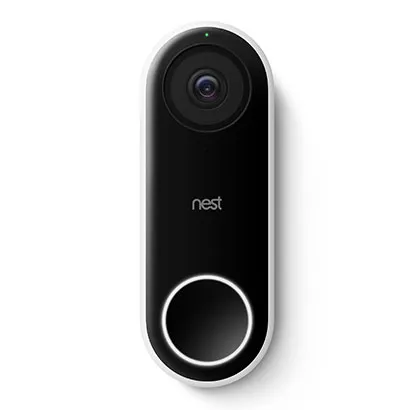
It you like the idea of your Google smart speaker announcing that “Your mother-in-law is at the front door” so you can scarper, or other useful heads-ups, such as the postman is here or Jonny just got home, the Hello doorbell will wow you with its powerful smart features.
The only smart doorbell with facial recognition, the Hello just needs you to identify people once in its app and it can tell you exactly who is at your door. It will also detect packages and alert you to sounds such as a dog barking, and can automatically shut off recording when you’re home so you don’t have hours of video of your comings and goings.
The facial recognition feature is optional, isn't enabled by default, and can be disabled in the app.
You do pay a pretty penny for these benefits however, but you get top-notch video quality and 24/7 recording, making this much more effective as a true security camera than any of the competition.
The downside is that all that video will eat through any bandwidth cap you might have, although you can adjust the quality of the stream to counter this. It also doesn’t play as well with Alexa, if that’s your smart speaker of choice.
Eufy Video Doorbell 2K
Best for privacy
Price: £199 | Subscription: No monthly fee | Resolution: 2560p x 1920p | Power Source: Wired or Battery
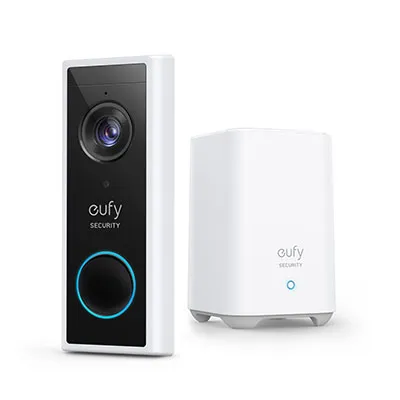
We cannot tell a lie; this one almost made the top spot.
Eufy’s newest doorknocker has the highest quality resolution of any doorbell on the market today and delivers a beautiful, crisp, clear picture. It works on a battery that it says will last 180 days (in our testing it was at 90 per cent after 2 weeks), so you can stick it anywhere you need to on your front door, making installation really simple (it can also be hardwired).
The killer feature is that it doesn’t rely on the cloud at all. Your video stays in your home on Eufy’s included HomeBase (which you plug into your router and also acts as an indoor chime). This means no subscription costs and no chance of anyone getting hold of your video from a cloud server.
But because it’s battery-powered (and even when wired) it suffers from the back-of-the head problem that plagues all similarly powered doorbells: It doesn’t always wake up in time to catch that person at your door before they walk away.
Ring Video Doorbell
Best budget doorbell
Price: £89 | Subscription: £2.50/month | Resolution: 1080p | Power Source: Wired or Battery
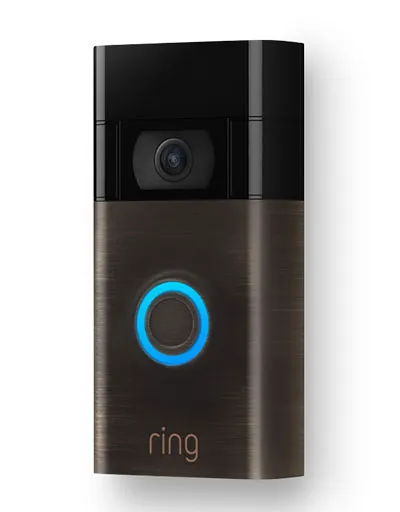
The original may not be the best, but for £89 you can’t go too far wrong with the Ring Video Doorbell. A basic buzzer that doesn’t require wires (but can use them if you have them), this does the job you need but you’ll have to take it down and charge it every couple of months – depending on whether your front door is like Heathrow at Christmas or Harrods in February.
There are fewer feature at this price but if you pay for the subscription it can alert you only when a person approaches, not every tree branch. We found this wasn’t always reliable – sometimes thinking a rocking chair was a person and other times entirely missing actual people – but it did cut down on alert fatigue.
All Ring’s doorbells work with Alexa speakers and smart screens and connect automatically to announce “someone is at the door” or show a live view. They also all have a wide, 16:9 aspect ratio, good for seeing the action as it approaches from either side, but not so great for keeping an eye on packages under the camera.
Ring is the only doorbell with privacy zones, which you can draw in so you’re not watching your neighbour’s house – but there’s no depth of field so everything in that space is blacked out. If you just want to know when someone is ringing your door and get to chat with them, and you use Alexa, this is a very good, entry-level option.
Ring 3
Best battery-powered doorbell
Price: £199 | Subscription: £2.50/month | Resolution: 1080p | Power Source: Wired or Battery
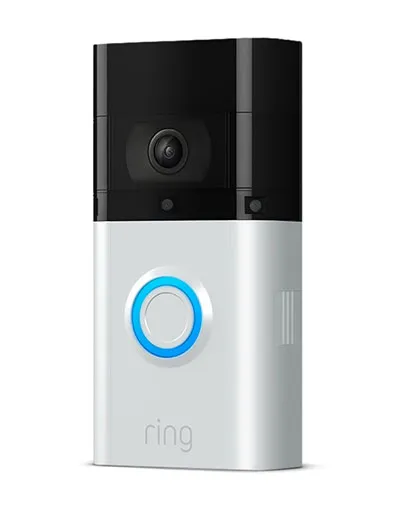
Ring has been making battery powered doorbells since the category was born and its newest model squarely tackles the back-of-the-head problem with a feature called Pre-Roll.
This adds three extra, tiny, low-powered cameras that are always recording but only serve up their footage when the main camera is triggered. When that happens, the doorbell adds a few seconds of grainy, black and white scenes to your regular video, so you don’t miss anything.
If you’re using your doorbell camera primarily as a security device and don’t want to risk missing the visage of someone who might be running away with a precious package, this feature is worthwhile. However, both Nest and Arlo include a few seconds of full colour pre-roll, thanks to their constant power source.
This makes Ring 3 Plus the best option if you can’t hardwire a doorbell (the Eufy doesn’t have any pre-roll), or don’t want to remove the entire doorbell to recharge it – it has a removable, rechargeable battery and you can buy spares for constant power source.
You can also buy an optional Ring Chime, a small speaker you plug in inside your home that will ring when your doorbell is pressed.
Ring Door View Cam
Our pick for renters or flat dwellers
Price: £119 | Subscription: £2.50/month | Resolution: 1080p | Power Source: Battery

For those who can’t install anything outside their front door at all, Ring’s Door View Cam slides right into an existing peephole so you can spy on your visitor both physically and digitally.
Powered by a removable, rechargeable battery, this is by far the easiest smart doorbell to install, taking less than 5 minutes to get set up and needing no tools or drilling, so your landlord will be happy.
It has all the features of the Ring Doorbell, but there are some limitations: Because it’s on the door and not next to it, when you open the door the camera looks at the wall in your hallway, not your visitor.
But it’s also well-tailored to life in a block of flats thanks to the privacy zones and adjustable motion sensitivity so you don’t get an alert as people pass your door only if they approach it.
Ring Pro
Best plug-in doorbell
Price: £229 | Subscription: £2.50/month | Resolution: 1080p | Power Source: Wired or Plug In
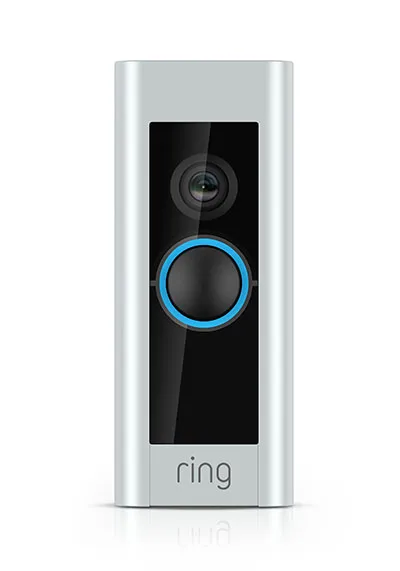
If you can’t hardwire your doorbell, don’t want to go to the expense of hiring an electrician, and don’t like the limitations of a battery-powered buzzer – Ring has another option.
The Ring Pro is its higher-end, wired model but it has a plug-in adaptor you can use to power your doorbell from a nearby outlet. It may require a bit of drilling to get the cables in the right place, but you won’t need your electrician’s licence.
The Pro is also Ring’s best consumer-level doorbell, although it costs as much as Google Nest’s Hello and doesn’t offer 24/7 recording or any smart alerts. But it does have a much clearer, brighter video than its battery-powered counterparts and less latency.
It has a slimmer form factor, because there’s no bulk battery, which means it will fit on narrower door frames. Ring also includes four different coloured faceplates to blend with your exterior paint job or match your door hardware.
August View
Best smart doorbell and smart door lock combination
Price: $229 (£174.90) | Subscription: $3/month | Resolution: 1920p x 1440p | Power Source: Battery
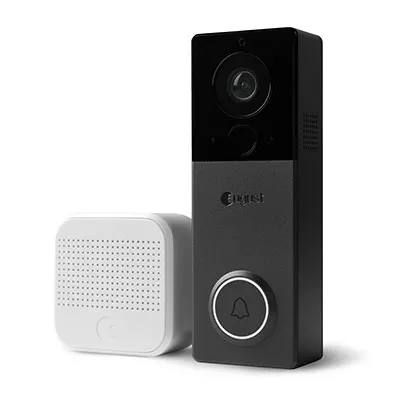
Once you have a smart doorbell, the desire for a smart lock may follow, so you can see who is at the door and let them in. This is helpful for service people, visiting relatives or just when your son forgot his key – especially if you have mobility issues.
August’s View Doorbell camera pairs with the company’s suite of smart door locks (including those by its sister company, Yale) to let you lock and unlock your front door right from the app you use to see and talk to visitors.
The View is a battery-powered buzzer, meaning although it's not available in the UK, if you get hold of one, there's no reason you can't use it.That also means that it can be slow to show you who is ringing, but once you’re connected, video quality is excellent, and being able to unlock the door from the view screen is very handy.
View has a removable, rechargeable battery, which is good as we found we had to charge it every couple of months.
But for a battery-powered doorbell it is very slim and sleek, and has the option of 7 different coloured faceplates (for an extra cost). It also comes with an electronic chime, and works with Alexa and Google smart speakers (but not screens).
- Not available in the UK
What's the best video doorbell for you?
If you have a smart speaker or screen, look for a doorbell that works with your choice of virtual assistant. Both Amazon’s Alexa and Google’s Google Assistant speakers can broadcast a message when your doorbell is pressed, and the smart screens act as a video intercom so you can see and speak to your visitor without having to pull out your phone. There are no smart doorbells that work with Apple’s HomeKit.
Streaming video from your doorbell takes a fair bit of bandwidth. Check how strong your Wi-Fi is by your front door before buying, and if it’s weak consider installing a Wi-Fi extender, oryou’ll struggle to get a good connection and reliable images.
A video doorbell records audio and video so falls under CCTV regulations. And, as it’s likely to see spaces outside your property – such as public streets or a neighbour’s walkway, any recorded footage falls under the General Data Protection Regulations act. If you are only using live streaming it’s not a problem, but if you are recording video be careful and be sure to use the included stickers that come with your smart doorbell to advertise to visitors they’re being recorded.
Audio is even more problematic in terms of privacy, but some companies – such as Ring – let you disable it completely if you’re worried. Facial recognition technology, offered by Google Nest, is another potential legal minefield still being tested in the courts, so proceed with caution.
Do watch out for your own privacy and security
When you bring internet connected devices into your home there is a risk they may be “hacked” by nefarious parties, or your data (in the case of smart doorbells - your videos) used in ways you don’t agree too. Of note, Amazon-owned Ring and Google-owned Nest have both had problems with cameras being hacked in the US, and Ring has come under scrutiny by privacy advocates in the US and UK for its partnerships with local police departments.
There are two things you can do: enable two-factor authentication on your accounts so you are the only person who can access them, and only buy products from well-known companies whose published privacy and data policies you're comfortable with.
Smart doorbell jargon buster
As you research the best options for making your front door smart, you’ll come across some of these phrases:
Latency: The amount of time between the moment a frame is captured and when that frame is displayed on the receiving screen. Long latency is an issue with most doorbells and means you’ll have to wait a few seconds to see your visitor and also for them to hear you.
Live view: Watching a live stream of video footage. All video doorbells offer this so you can check in on your doorstep even if you didn’t get a motion alert.
Two-way audio: The ability to hear audio from video footage and transmit audio to the same stream. It requires your doorbell to have both speaker and microphone.
Cloud storage: An online space where recorded video is stored so it can be accessed from anywhere you have an internet connection.
Aspect ratio: The dimension of the video footage you will see through your doorbell’s camera. A wider aspect ratio such as 16:9 will show you more side-to-side but may cut off faces and feet. A squarer ratio such as 4:3 or 1:1 offers a more head-to-toe view.
